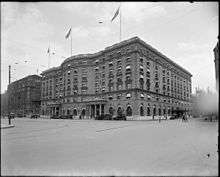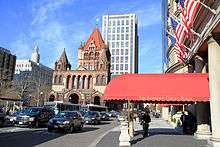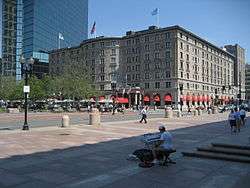The Fairmont Copley Plaza Hotel
| The Fairmont Copley Plaza | |
|---|---|
|
The Fairmont Copley Plaza and Copley Square, 2007 | |
| General information | |
| Location | 138 St. James Avenue, Boston, Massachusetts, United States |
| Opening | 1912 |
| Owner | FelCor Lodging Trust Inc. |
| Management | Fairmont Hotels and Resorts |
| Design and construction | |
| Architect | Henry Janeway Hardenbergh |
| Other information | |
| Number of rooms | 383 |
| Website | |
| Fairmont Copley Plaza | |
The Fairmont Copley Plaza is a Forbes three-star, AAA four-diamond hotel[1][2] in downtown Boston, Massachusetts owned by Fairmont Hotels and Resorts. It stands on Copley Square, part of an architectural ensemble that includes the John Hancock Tower, Henry Hobson Richardson's Trinity Church, and Charles Follen McKim's Boston Public Library.[3]
The Fairmont Copley Plaza is recognized as one of the Historic Hotels of America, a program of the National Trust for Historic Preservation.[4] It is currently under consideration for local landmark status with the Boston Landmarks Commission [5]
Construction and opening


The Copley Plaza was built on the original site of the Museum of Fine Arts[6] and named in honor of John Singleton Copley, an American painter. The total cost was $5.5 million.
The hotel's architect was Henry Janeway Hardenbergh, who also designed other hotels, including the Willard Hotel in Washington D.C. and the Plaza Hotel in New York City, the Copley Plaza's sister hotel.[6][7] The seven-floor hotel is constructed of limestone and buff brick in the Beaux-Arts style. The E-shaped building is supported by pilings driven to a depth of 70 feet (21 m) below the street level.
When it opened in 1912, the Boston Mayor John F. Fitzgerald presided over a reception of over a thousand guests. Rooms had been booked as early as 16 months in advance. Its first manager, who also lived at the hotel, served for 22 years and he and the hotel were so prominent as to merit an obituary in the New York Times.[8] It became for some years the site of the annual Harvard-Yale dance and other post-football dances, denounced by the authorities of local women's colleges who forbade their students from attending: "These dances have nothing to do with the colleges in question, but have merely a financial interest in them. There is not doubt that they are of an extremely questionable nature owing to the fact that they are entirely opened to the public."[9]
The hotel marked its centennial with another ribbon cutting ceremony by Boston Mayor Thomas Menino on August 16, 2012.[10]
Ownership
The hotel was bought by Sheraton Hotels in the early 1950s and operated as the Sheraton-Plaza Hotel until Sheraton sold it to John Hancock Insurance in 1973, when it regained its former name. Hancock hired Boston hospitality management firm Hotels of Distinction's William Heck to run the Copley Plaza. During this time, the restaurants in the hotel were considered some of the best in the city and featured such chefs as Lydia Shire, Jasper White, and Gordon Hamersley. John Hancock sold the hotel in 1989 to a subsidiary of Harvard University.[11] In the mid-1990s, Harvard brought in Wyndham Hotels & Resorts to manage the Copley Plaza and it became the Wyndham Copley Plaza. Fairmont Hotels and Resorts then bought the hotel from Harvard in September 1996 and renamed it the Fairmont Copley Plaza.[12] Fairmont sold the hotel to FelCor Lodging Trust Inc. in 2010 as part of a movement away from direct real estate ownership, but continues to manage it.
Features

The entrance hallway has been called Peacock Alley since the 1920s. The 5,000-square-foot (460 m2) lobby has a 21-foot (6.4 m) high gilded coffered ceiling with matching Empire style crystal chandeliers and Italian marble columns. Much of the classical architecture and decor has been preserved, including the back-to-back "P" monogram.
The hotel is known for these industry firsts: the first hotel completely air-conditioned in Boston, the first hotel with an international reservations system, and the first to accept credit cards.
Events
From its opening, the hotel was a center of the social life of Boston's elite. In 1913, Hamilton Fish, Jr., held a "Lenten dance" where "society leaders ... from New York, Philadelphia, Chicago, Washington and Boston greeted the coming of daylight this morning at the Copley Plaza Hotel".[13]
In the 1920s, John Singer Sargent kept rooms at the hotel and painted portraits there.[14] Sargent used one of the hotel's employees, a black elevator operator named Thomas McKeller, as the model for Apollo in his decoration of Boston's Museum of Fine Arts.[15]
Frederick Kerry, paternal grandfather of U.S. Sen. John Kerry, committed suicide with a gunshot to the head in the restroom of this hotel on November 23, 1921.[16]
In the 1930s, the Boston Horse Show awarded the Copley-Plaza Challenge Trophy.[17]
In February 1935, civic leaders held a dinner for Babe Ruth at the Copley Plaza to celebrate his return to Boston after 16 years with the New York Yankees.[18]
On March 29, 1979, a disgruntled former employee set multiple fires in both the Copley Plaza and the nearby Sheraton Boston hotels. The fire at the Copley Plaza, which was occupied by 430 people at the time, injured thirty and killed one.[19] Among those injured was media mogul Sumner Redstone, who survived by hanging from a third-story window. His hand was partially paralyzed from the fire. Film director Rob Cohen was also rescued from the fire.[20]
Guests

The Copley Plaza Hotel has been host to many famous people. Every U.S. President since William Howard Taft, and royalty from Greece, Thailand, Abyssinia, Saudi Arabia, Iran, Belgium, Denmark, and the United Kingdom have visited the hotel. Celebrities including John Lennon, Tony Bennett, Lena Horne, Dorothy Lewis, Frank Sinatra, and Luciano Pavarotti have also been guests. Elizabeth Taylor and Richard Burton chose the Copley Plaza for their second honeymoon.[21]
In popular culture
The climax of Robert B. Parker's 1973 Spenser novel The Godwulf Manuscript takes place in Room 411 of the hotel.
The hotel provides the setting of a few scenes in the 1999 cult classic "The Boondock Saints"
References
| Wikimedia Commons has media related to The Fairmont Copley Plaza Hotel. |
- ↑ http://www.forbestravelguide.com/fairmont-copley-plaza-boston-ma-hotel.htm
- ↑ http://www.aaa.biz/approved/Diamond_Awards/2010/2010_4D_Lodgings.pdf
- ↑ Teresa M. Hanafin (1988-10-30). "Quality Inn Owner in Serious Talks to Buy 'Grande Dame' Copley Plaza". Boston Globe.
- ↑ "Historic Hotels of America". National Trust for Historic Preservation. Retrieved 13 August 2012.
- ↑ https://www.cityofboston.gov/images_documents/PETSTATS_June2016_tcm3-53570.pdf
- 1 2 Mary Melvin Petronella and Edward W. Gordon (2004). Victorian Boston today: twelve walking tours. UPNE. p. 70. ISBN 9781555536053.
- ↑ Marie Morris (2005). Frommer's Boston 2006. Frommer's Series. 112. John Wiley and Sons. p. 79. ISBN 9780764588907.
- ↑ "Robert S. Gardner". New York Times. 18 May 1940. Retrieved 13 August 2012.
- ↑ "5 Colleges Bar Girls from Football Dance". New York Times. 19 November 1925. Retrieved 13 August 2012.
- ↑ Kaiser, Johanna (16 August 2012). "Fairmont Copley Plaza celebrates 100 years with second ribbon cutting". Boston Globe. Retrieved 20 August 2012.
- ↑ "Hancock to Sell Copley Plaza". New York Times. 5 November 1988. Retrieved 13 August 2012.
- ↑ Julie Hatfield (1997-02-25). "Renovators Check in at Copley Plaza New Owners Vow to Restore Old Luster". Boston Globe.
- ↑ "Hamilton Fish, Jr., Gives Lenten Ball". New York Times. 22 February 1913. Retrieved 13 August 2012.
- ↑ Trevor Fairbrother, John Singer Sargent: The Sensualist (Seattle Art Museum, 2000), 111
- ↑ Guy C. McElroy, Facing History: The Black Image in American Art, 1710-1940 (Corcoran Gallery of Art, 1990), 111
- ↑ Michael Kranish, Brian Mooney, Nina J. Easton, John F. Kerry: The Complete Biography By The Boston Globe Reporters Who Know Him Best (Boston Globe, 2004), 5
- ↑ "Erin's Son Victor in Hunter's Contest". New York Times. 16 October 1937. Retrieved 13 August 2012.
- ↑ Dawson, James P. (1 March 1935). "Ruth is Acclaimed by Fans in Boston". New York Times. Retrieved 13 August 2012.
- ↑ "2,000 Flee 2 Boston Hotel Fires; 64 Hurt". New York Times. 30 March 1979. Retrieved 13 August 2012.
- ↑ Paul A. Christian, Boston's Fire Trail: A Walk Through the City's Fire and Firefighting History (Boston Fire Historical Society), 61-62
- ↑ Sam Kashner and Nancy Schoenberger, Furious Love: Elizabeth Taylor, Richard Burton, and the Marriage of the Century (HarperCollins, 2010), 101
External links
- Fairmont Copley Plaza official website
- Fairmont Copley Plaza on Historic Hotels of America
- Wulff, June (15 August 2005). "Catie Copley: For the Fairmont Copley Plaza's canine ambassador, every day is a walk in the park". Boston Globe. Retrieved 2009-08-12.
- Associated Press (3 December 1987). "Hotel maids told: do floors by hand". New York Times. Retrieved 2009-08-12.
Coordinates: 42°20′57″N 71°04′35″W / 42.349295°N 71.076286°W
